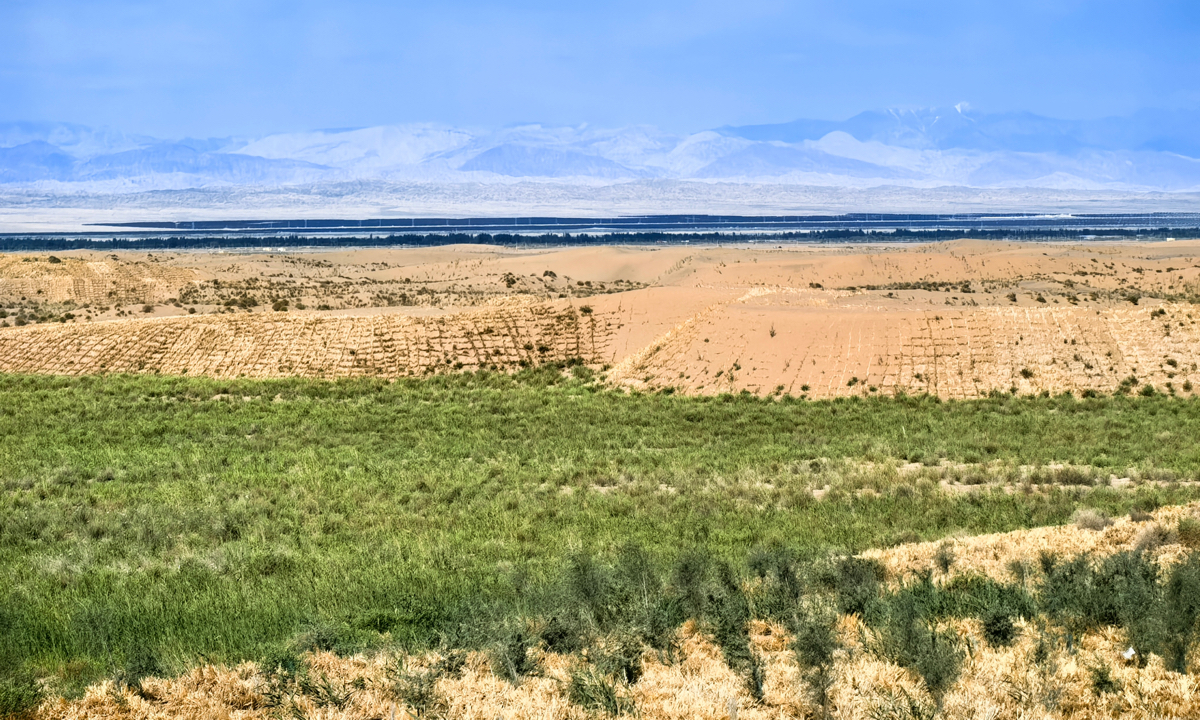
Sand-blocking green belt in Shache county in Xinjiang Photo: Shen Sheng/GT
This Tuesday marked the 31st World Day to Combat Desertification and Drought. Along the edge of the Taklimakan Desert, towns and villages in Northwest China’ s Xinjiang Uygur Autonomous Region are leveraging technological innovation to fuel the integrated growth of desert tourism, protected agriculture and sand-based industries.
In the desert of Shache county in Xinjiang, a large-scale sand control project is well underway. Stretching across the vast desert, orderly grids of straw checkerboards effectively stabilize the shifting sand dunes and help control desertification. Made from reeds and straw, each square is one meter by one meter, half-buried in the sand to reduce wind speed and stabilize the surface.
“In the past, sandstorms destroyed our crops and forced families to move away. Now, the sand is contained, vegetation is spreading, and our lives are improving,” said a resident of Shache county.
According to local authorities, official figures show that the county has completed 4,400 mu (293.48 hectares) of sand barrier installations, engaging more than 4,500 formerly impoverished or monitored households in the process. These efforts have not only improved the local environment but also brought tangible economic benefits to local residents.
Since 2012, Markit county of Kashgar in Xinjiang has launched an ecological forest project for windbreaking and sand-fixation. Through planting 460,000 mu of trees, including desert poplar, Euphrates poplar, and oleaster, the county has established a robust green shield. Wang Yufeng, Party Secretary of the county forestry and grassland bureau, told the Global Times on Tuesday that thanks to afforestation, sandstorm days have dropped from more than 150 in 2010 to fewer than 50, and annual rainfall has increased from around 50 millimeters to over 110 millimeters. The spread of desertification into oases has been effectively contained.
In a township of Xinjiang’s Bachu county, a new ecological restoration model is transforming lives. By planting medicinal herbs like Cistanche deserticola beneath hardy desert shrubs such as suosuo trees, also known as haloxylon ammodendron, residents are seeing both environmental and economic gains. “In the past, our homes were buried by sandstorms,” recalled local villager Buheliqimu Maihemuti. “Now we grow Cistanche deserticola under the trees and earn extra income. Life is getting better.”
When Nurjilimali Aimudula first joined the forestry and grassland bureau in Awat county of Aksu city in Xinjiang, she was met with a harsh and unforgiving landscape — nothing but sand as far as the eye could see. Desert control efforts were still in their infancy, and the team had just begun experimenting with drip irrigation systems, which at the time were far from reliable.
“One freezing winter, the irrigation pipes burst. I had to fix them in the cold, and ended up soaked from head to toe,” she recalled with the Global Times on Sunday. “I had just graduated from university. I was in the middle of the desert and I couldn’t stop crying.” Despite the hardships, Nurjilimali never considered giving up. “I’m from Awat, and I’m committed to helping my hometown push back the desert,” she said.
The greenery, almost imperceptible amid the dim yellow sky, shone like the first torch kindled in the night, bringing a burst of brightness to her. After three years of dedicated effort, she and her colleagues had promoted the rehabilitation and restoration of the original wetland ecosystem by strategically harnessing local renewable water resources and seasonal ecological water reserves. Through methods such as artificial seedling transplantation, sowing, supplementary irrigation, and other innovative techniques, they successfully revived desert xerophytic vegetation, fostering a relatively stable desert ecosystem within the region.
Technological innovation in ecological protection and restoration At Tarim University in Xinjiang, Professor Li Zhijun has spent years studying the desert populus euphratica, developing a set of advanced techniques for its conservation and restoration — including rotational zoning, trench irrigation and flood irrigation.
"These methods have been implemented across 41.55 million mu of desert poplar habitat in Xinjiang," Li told the Global Times on Saturday. "They’ve significantly improved survival rates and ecological function, laying a solid foundation for protecting ecosystems on the edge of the desert."
In desert-based greenhouse agriculture, Professor Wang Xufeng from the University of Chinese Academy of Sciences has developed yellow-sand matrix cultivation technology and intelligent farming equipment. "Our system enables smart, mechanized vegetable production, and it boosts yield and quality while reducing costs," said a team member.
In Xayar county, Aksu Prefecture, desertification control efforts have advanced by integrating solar technology with afforestation. The county has installed over 30 distributed photovoltaic-powered water extraction systems, each supporting irrigation on 2,000 mu of desertified land. These systems pump shallow saline water to grow hardy, salt-tolerant vegetation such as Haloxylon via drip irrigation.
So far, the initiative has greened 63,000 mu, with a forest survival rate exceeding 80 percent. The solar-powered systems save over 3 million yuan ($415,000) annually in electricity costs, with the panels themselves serving a secondary function of shielding seedlings from wind damage.
To address the challenge of saline water desalination, Chen Haotian, assistant general manager of Xingya Water Group in Xayar, shared how the county has partnered with Zhejiang University to refine desalination techniques. Their solution purifies groundwater with a salt content of 17 mg/L down to just 0.12 mg/L — clean enough to irrigate crops such as wheat, bok choy and rapeseed. In addition to irrigation, the brine byproduct is sun-dried and processed into industrial-grade de-icing agents.
Desert economy drives diversified and integrated development Building on ecological restoration, Xinjiang is exploring diverse desert-based industries. In Markit county’s N39 Desert Scenic Area, activities such as off-road racing, desert camping and therapeutic sand baths are gaining popularity. “The desert scenery here is awe-inspiring, and the experiences are thrilling. It’s a side of the desert we’ve never seen,” one tourist told the Global Times.
Dong Mingjiang, general manager of the scenic area, explained, “Events like the Taklimakan Rally have boosted our visibility. In 2025, we have welcomed over 115,000 visitors, generating 45.65 million yuan in tourism revenue. We’re transitioning from destination tourism to integrated, multi-sector development.”
In terms of industrial development, the Cistanche industry in a township of Bachu county is a standout. Combining Haloxylon reforestation with Cistanche cultivation, the initiative has increased farmer incomes.
Xayar county has established a desert industry research lab focused on developing new techniques for desert herbs like populus euphratica alkaloids, Apocynum venetum and Cistanche. With support from doctoral researchers from Xinjiang Medical University, the lab has launched a line of Cistanche-based skincare products, with plans to expand into food and pharmaceuticals to lengthen the value chain.
As villager Abudumoming Yiming puts it, “We used to survive just by farming with barely enough income. Now, growing Cistanche brings us about 500 yuan per mu. Life is truly getting better.”
Xinjiang's people turn deserts into oases through hard work and wisdom. It has not only wrapped the desert in a green scarf, advancing the overall improvement of the ecological environment, but also transformed this "green scarf" into a continuous driving force to enhance the lives of local residents.




